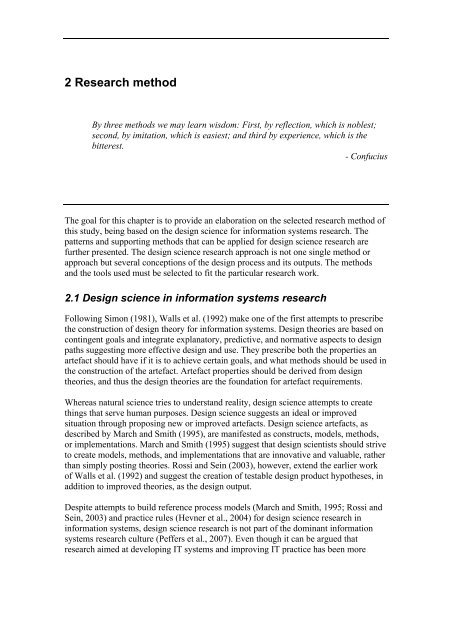Multi-channel provisioning of public services - Department of ...
Multi-channel provisioning of public services - Department of ...
Multi-channel provisioning of public services - Department of ...
You also want an ePaper? Increase the reach of your titles
YUMPU automatically turns print PDFs into web optimized ePapers that Google loves.
2 Research method<br />
By three methods we may learn wisdom: First, by reflection, which is noblest;<br />
second, by imitation, which is easiest; and third by experience, which is the<br />
bitterest.<br />
- Confucius<br />
The goal for this chapter is to provide an elaboration on the selected research method <strong>of</strong><br />
this study, being based on the design science for information systems research. The<br />
patterns and supporting methods that can be applied for design science research are<br />
further presented. The design science research approach is not one single method or<br />
approach but several conceptions <strong>of</strong> the design process and its outputs. The methods<br />
and the tools used must be selected to fit the particular research work.<br />
2.1 Design science in information systems research<br />
Following Simon (1981), Walls et al. (1992) make one <strong>of</strong> the first attempts to prescribe<br />
the construction <strong>of</strong> design theory for information systems. Design theories are based on<br />
contingent goals and integrate explanatory, predictive, and normative aspects to design<br />
paths suggesting more effective design and use. They prescribe both the properties an<br />
artefact should have if it is to achieve certain goals, and what methods should be used in<br />
the construction <strong>of</strong> the artefact. Artefact properties should be derived from design<br />
theories, and thus the design theories are the foundation for artefact requirements.<br />
Whereas natural science tries to understand reality, design science attempts to create<br />
things that serve human purposes. Design science suggests an ideal or improved<br />
situation through proposing new or improved artefacts. Design science artefacts, as<br />
described by March and Smith (1995), are manifested as constructs, models, methods,<br />
or implementations. March and Smith (1995) suggest that design scientists should strive<br />
to create models, methods, and implementations that are innovative and valuable, rather<br />
than simply posting theories. Rossi and Sein (2003), however, extend the earlier work<br />
<strong>of</strong> Walls et al. (1992) and suggest the creation <strong>of</strong> testable design product hypotheses, in<br />
addition to improved theories, as the design output.<br />
Despite attempts to build reference process models (March and Smith, 1995; Rossi and<br />
Sein, 2003) and practice rules (Hevner et al., 2004) for design science research in<br />
information systems, design science research is not part <strong>of</strong> the dominant information<br />
systems research culture (Peffers et al., 2007). Even though it can be argued that<br />
research aimed at developing IT systems and improving IT practice has been more
















